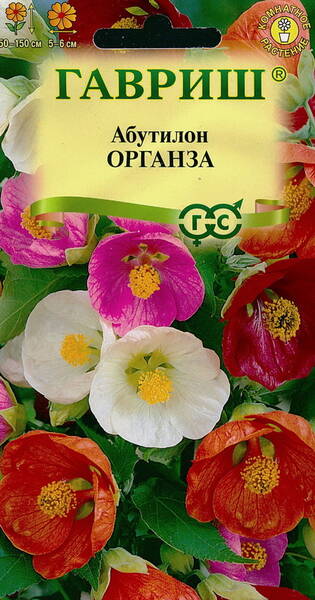It is impossible to find a more unpretentious flowering plant for bright rooms than indoor maple.
Abutilon, also known as the abutilon or indoor maple, is a beautiful, abundantly branching evergreen shrub in the Malvaceae family. The leaves are three- to five-lobed, maple-shaped, softly pubescent, green, and up to 12 cm long. Delicate drooping flowers in shades of gold, white, pink, and red are borne singly or in pairs in the leaf axils.
An easy-to-grow, sun-loving indoor plant, it doesn't require much heat or humidity. In winter, keep it in a bright, cool room, and in summer, it's recommended to place it on a balcony in partial shade.
Abutilon is easily propagated by seed. The seeds are evenly distributed over the surface of a pre-moistened peat-sand mixture (1:1), then covered with a 3-5 mm layer of the same, but dry, soil. Seedlings appear in three weeks. After the second pair of true leaves develop, the plants are transplanted into individual pots. Abutilon blooms within five months of sowing. During the summer and spring, while the shoots are growing, abundant watering is necessary. In winter, it is sufficient to prevent the soil from drying out. For lush and abundant flowering, it is recommended to prune the shoots by half their length in the spring.

* Abutilon hybrid.
Abutilon blooms profusely and continuously with beautiful flowers of varied colors, boasting a lush crown of delicate, downy leaves, yet is unpretentious. It reproduces easily, grows quickly, and yet requires little care—all of these qualities make it a favorite among gardeners. Abutilon leaves, which increase air humidity, help improve the indoor microclimate.
Abutilon is a genus of annual and perennial plants in the Malvaceae family. More than 150 species of this genus are found in the tropics and subtropics; they are herbs, shrubs, or small trees. The coarse fiber obtained from these wild plants, used to make rope and other woven items, gives Abutilon its second name—"rope fiber."
The most common houseplants are: Abutilon sellovianum and its varieties with striped leaves; Abutilon megopotanicum , which blooms profusely almost all year round; and Abutilon hybridum, obtained by crossing different species.
Indoors, Abutilon indica with cream flowers, Abutilon vinifola with pink flowers, hanging Abutilon brasiliensis, and others are also grown.
The indoor abutilon is a fast-growing container plant; it can quickly become crowded on a windowsill and will require more space. It is an evergreen tree or shrub up to 1.5 meters tall, with fairly large leaves and drooping lantern-shaped flowers on long stalks that adorn the crown of leaves from early spring to late fall (sometimes year-round). The pointed, soft, lobed leaves with irregularly serrated edges, reminiscent of maple leaves, have given the abutilon its third name—"indoor maple."
There are numerous abutilon cultivars with green, golden-spotted, and variegated foliage, a variety of flower colors, and varying crown heights and compact habits. Abutilon's bell-shaped flowers, with numerous stamens and a long pistil, come in single or double varieties, with vibrant corolla petals: white, gold, orange, pink, red, and burgundy.
Abutilon loves light but does not tolerate being moved quickly into bright light. It's beneficial to move the abutilon tree outdoors in the summer, into the garden or onto a balcony, choosing a sheltered, semi-shaded location. At high temperatures, misting the crown is recommended. Under favorable conditions, abutilon produces significant growth over the summer.
Abutilon requires abundant watering from March to August (if the substrate dries out, it will lose leaves and buds). After watering, be sure to remove any excess water from the tray. Abutilon should be watered very sparingly from September to February (just lightly moistening the root ball); overwatering also leads to leaf drop.
Abutilon overwinters in a bright, cool location; the optimal temperature is 10-14°C (50-57°F). It is important to avoid direct sunlight. During winter, mist the crown periodically. In spring, before the active growing season begins, the abutilon shoots should be pruned (by one-third to two-thirds of their length, depending on the condition of the crown). Pruning is necessary to create a compact and attractive crown and ensure abundant and long-lasting flowering. As the young shoots begin to grow, provide warm, humid conditions. To encourage branching, pinch the tips of the young shoots.
Every spring, the abutilon is replanted into a new pot, only slightly larger than the previous one, because abundant flowering occurs only if the root ball is well intertwined with roots.
Abutilon requires a nutritious, dense substrate composed of a mixture of clayey turf, humus, leaf soil and sand in a ratio of (2:1:1:0.5).
Abutilon is fed with complete mineral fertilizer and liquid manure from March to August twice a month (if there is a lack of nutrition, the lower leaves fall off).
Green-leaved abutilon varieties are propagated by seeds and cuttings; variegated varieties are propagated only by cuttings. Abutilon seeds germinate readily when sown in warm soil (22°C/72°F) in spring. Seedlings grow quickly, so they are transplanted into larger pots 2-3 times during the summer. Abutilon can be propagated by cuttings throughout the year, but herbaceous cuttings with removed buds root more quickly in spring, and semi-woody cuttings root more quickly in August. Cuttings are rooted in sand or a 1:1 peat-sand mixture in a "mini-greenhouse" with warm soil (22-25°C/72°F).
The soft leaves of abutilon are often attacked by pests such as aphids, scale insects, and spider mites. Scale insects should be carefully removed from the leaves with a cotton swab. If pest infestations are few, the plant can be sprayed with a soap or tobacco solution. A traditional method of controlling abutilon pests has been to infuse the tree with horse sorrel infusion, spraying the tree every 10 days until the pests disappear. In case of severe pest infestation, an insecticide (such as an Actara or Actellic solution: 2 ml per liter of water) can be used to treat abutilon.
Bot. syn.: Abutilon darwinii x Abutilon pictum.












